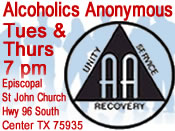February 24, 2020 - East Texas residents are familiar with border towns and their frequently unsavory reputation by virtue of Texas' border with Mexico. However, many residents of East Texas and Western Louisiana forget that the Sabine River was once the border between the United States and Mexico and this area was a dangerous place to live.
Historian Stanley Fletcher of Leesville, Louisiana has studied the period and shared some interesting and little known facts about our area's past with members at the February 19th monthly meeting of the Timpson Area Genealogical and Heritage Society. In a talk entitled “Inlaws and Outlaws of West Louisiana and East Texas,” Mr. Fletcher opened his remarks by saying the reason for the title was that “the Twenty Percenters at the top of the society married other Twenty Percenters,” therefore the same family names crop up in the history of the area, sometimes on either side of the law.”
With the Louisiana Purchase in 1803, this area became the border between the two nations. The boundary was somewhat ill defined, a fact that was recognized by the establishment of the Sabine Free State of “Neutral Zone” between the Sabine River on the west and Arroyo Hondo, Coshatta Creek, and Rio Hondo on the east. Mexico and the United States agreed that neither county would take any unilateral action in this area. This left law enforcement up to the residents of the Neutral Zone and the law's somewhat sporadic and uneven enforcement made the area attractive to bandits and outlaws, Fletcher said.
There was an influx of this societal element into the Neutral Zone after 1821, when the first steamboats began operating on the Mississippi River. “Prior to the advent of Mississippi steamboats” Fletcher explained, “traders who had traveled down the Mississippi with their goods to sell in New Orleans, had to travel by land up the Nachez Trace to return home.” Bandits preyed on these travelers for the money they had made in New Orleans. “With the steamboats came the ability for traders to return home by the same route they had come down and to avoid the dangerous Nachez Trace.” The bandits had to look elsewhere for a suitable enviornment and the Neutral Zone attracted many of them, including the notorious John A. Murrell, also know as “Reverend Devil” and “The Great Western Land Pirate,” and his gang.
While a great many persons who sought to avoid encounters with the law came to the Neutral Zone, the notion that the area was entirely lawless is erroneous, Fletcher shared. In a portion of his talk he calls “Lies My Teacher Told Me” Mr. Fletcher revealed that 280 “lawful” families lived in the Neutral Zone. In addition, he said, in 1812 both Zebulon Pike and Mexican authorities made patrols through the zone, with another such patrol being made in 1816. Finally, Fletcher said that the idea that the area was entirely wilderness is wrong. “The area had developed “communities” along Nolan's Trace, El Camino Real, and the Coshatta Cattle Trail,” he said.
Still, day-to-day law enforcement was done by a group vigilantes know as the Regulators. “The Regulators were organized to stop cattle rustling, land swindling, business frauds, and other crimes.” Law enforcement by the Regulators was often questionable and frequently self-serving. Eventually enough citizens felt that the Regulators were more of a problem than a solution and the Moderators were formed to police the Regulators. Members of both groups could occasionally be found on the wrong side of the law and the “bitterness spilled over into East Texas after 1821, when the U.S. Government took over the Neutral Zone”.
The conflict between the Regulators and the Moderators degenerated into open warfare between 1839 and 1844 in Shelby and Harrison Counties of Texas. Now known as the Regulator-Moderator War, the conflict resulted in 52 deaths and finally ended in 1846 with the coming the Mexican War.
The Timpson Area Genealogical Society meets at 2PM on the third Wednesday of each month in the meeting room of the Timpson Public Library on the corner of Austin and Bremond Streets in downtown Timpson. The TAGHS library is located within the Timpson Public Library and is open and staffed from 9AM until 5PM weekdays. Telephone 936-254-2966 and ask for the Genealogical Library.









